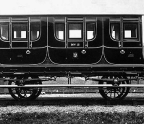
The Grand National was a national event from its earliest days and doubtless a cause of some of the earliest special race trains. It formed the highlight of the Liverpool Spring Meeting at Aintree, held on Thursday, Friday and Saturday, the big race being run on the Friday - it moved to the Saturday from 1940. This horse race dates from 1839 and for the first few years everything that could turn a wheel was used to carry people from Liverpool to Aintree by the Preston road in a procession described as “riot and rout”. But it really came into its own with the arrival of the railways.
Lancashire & Yorkshire Railway
The ‘Railway Mania’ produced the Lancashire & Yorkshire Railway, connecting Liverpool with Manchester via Wigan (November 1848) and the East Lancashire - which ran to Blackburn via Preston (April 1849). These Companies operated a joint line from the terminus at Great Howard Street to Walton Junction - both then had their own stations at Aintree. For the July meeting in 1849 the two companies advertised a train every ten minutes from the Liverpool terminus to the East Lancashire station, named Sefton Arms for the occasion. This is the first reference to this name, based on a well-known hostelry by the enhance to the racecourse: for many years the name was only used on race days. The LYR’s Aintree station was less well placed than the ELR’s and I expect the traffic was more than enough for both companies to cope with. A notable feature of this advertisement is that first class trains were run “from near the Goods Warehouse Enhance - the Yard of the Goods Warehouse” at Great Howard Street, while third class passengers were to use the usual passenger entrance. There would also be a separate departure platform for first class when returning from Sefton Arms. This segregation of the classes seems odd now, but with the crowds assembled on these occasions the railways would otherwise have struggled to restrict the first class accommodation to those with the appropriate tickets. One can also imagine that a gentleman with a gold watch and a supply of cash for punting on the horses would prefer not to be caught up in a heaving crowd that certainly contained some skilled pickpockets. Once in a first class compartment, he would still need to steer clear of dodgy card parties.

Things were not managed well at the end of February 1851; perhaps this being the first Grand National handled from the new Tithebarn Street (or Exchange) station was a factor. The special trains were “crowded to excess” - “People who took first-class tickets were compelled to put up with third-rate accommodation, and were crushed almost to suffocation.” With doors unlocked, trains were rushed from both sides and hundreds made the return journey on the roofs of the carriages. It was noted in 1875 that the ploy of running all-first class trains accessed from a separate




